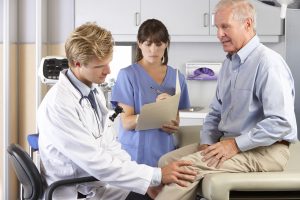 Pain behind knee is not unusual, but it can hurt and limit movement. Developing a clear understanding of pain behind knee causes can be important.
Pain behind knee is not unusual, but it can hurt and limit movement. Developing a clear understanding of pain behind knee causes can be important.
When we refer to pain behind knee, we are really talking about discomfort or soreness behind the knee joint. This uncomfortable feeling can happen to a person who still has movement in their knee or it can severely limit movement. Sometimes, pain behind knee is accompanied by inflammation or a burning sensation. In many cases, the soreness is nothing to worry about. There are situations where the pain does not disappear, and there is swelling or even bruising. If this happens to you, it is important to seek medical attention.
Pain behind the knee: Symptoms
Advertisement
Each case of pain behind the knee is different. However, there are some typical signs and symptoms doctors have identified, including the ones listed below.
- Inability to put weight on knee
- Reduced range of motion in knee joint
- Stiffness
- Swelling
- Pain when trying to stretch the leg
There are some symptoms that can be an indication of a life-threatening health problem. For example, bruising on the back of the knee or calf, difficulty breathing, redness behind the knee of one leg, warmth behind the knee of one leg, and painful swelling can be signs of something serious.
 Common causes of pain behind the knee
Common causes of pain behind the knee
Sometimes pain behind the knee is simply due to muscle strains. These injuries usually heal in a matter of days. However, this is only one possibility. There can also be pain behind the knee as a result of systemic diseases or some life-threatening conditions. Below we take a look at just what the different potential causes are.
Injury-related causes
Hamstring injury – The hamstrings are one of three posterior thigh muscles. It is a common site of injury in athletes. The most common tendon behind knee pain is the biceps femoris tendon, and it’s commonly injured during activities like kick boxing, downhill running, and sprinting. Injury at this location will produce a dull ache that quickly intensifies with sudden movement. Mild swelling behind the knee may also occur.
Meniscus tear – A sudden twisting of the knee or even long-term overuse can cause a tear of the meniscus, which is two crescent-shaped pieces of cartilage found in the knee. Tears of the meniscus can cause pain in the knee as well as a “locking” sensation, swelling, and difficulty with knee extension. While conservative management with RICE treatment is usually enough, some individuals may require surgery.
Posterior cruciate ligament (PCL) injury – Injury to the PCL, which is one of the longest ligaments in the knee, can lead to pain, swelling, and difficulty standing. Overextension or a forceful blow to the front of a bent knee are common causes of a PCL injury. Due to the PCL being able to heal quickly, non-surgical treatment is all that is usually required. However, surgery may be required if there is a concomitant injury such as knee dislocation.
Disease-related causes
Osteoarthritis (OA) – This is degeneration of the cartilage that provides cushioning between the bones of the joints. Cartilage between the knee joint is required to cushion forceful impacts that occur on a regular basis. Without this protection, both sets of bones will continually rub against each other, causing knee pain.
Rheumatoid arthritis (RA) – This occurs when the body’s immune system attacks the synovial lining of joints. It can be a common problem in the knee. Symptoms include pain that is worse in the mornings, swelling, and stiffness. Autoimmune inflammation will eventually lead to the destruction of the joint if disease-modifying antirheumatic drugs (DMARDs) are not taken.
Gout – This disease is known to build up uric acid in the blood. As a result, crystals can form deposits in joints, leading to pain. Uric acid is a waste product that is usually excreted from the body. When the body is unable to excrete sufficient amounts or is producing too much uric acid, crystals begin to form and deposit in the joints, such as the knee. This can lead to the knee becoming swollen, red, and warm, causing knee pain.
Popliteal cysts – Also known as Baker’s cysts, these can lead to fluid buildup in the knee joint and can be the result of an injury or a disease. While it can be painless for some people, others find it very uncomfortable and report that it impacts their range of motion. The normal course of action is to treat the underlying injury or disease. It is rare for a cyst to be drained or surgically removed, especially if it is large.
Deep vein thrombosis – This is a blood clot that can develop in a vein. Blood clots happen most often in the large veins of the thigh and calf. Prolonged sitting, cardiovascular disease, and a family history of deep vein thrombosis put people at an increased risk for this condition. Since this condition can lead to a clot breaking free and traveling to the lung, it is classified as life-threatening.
Tumor – Although they rarely cause pain behind the knee, liposarcomas, osteosarcomas, and osteochondroma are tumors that can be found behind the knee. Liposarcomas and osteosarcomas are malignant, while osteochondroma is a benign tumor.
Treatment and prevention tips for pain behind the knee
When you experience knee pain that doesn’t go away within a day or two, you should seriously consider health care. Here are a few tips on protecting your knee in situations where you might have a minor knee injury or experience reoccurring knee problems.
- Avoid activities that cause pain
- Apply ice
- Keep knee raised to bring down any swelling
- Sleep with a pillow underneath or between your knees
- Avoid running up and down stairs – walk carefully
- Don’t forget to warm up before exercising or engaging in sports
- When you run, do it on smooth, soft surfaces instead of rough pavement
- Swim instead of running
- If you are overweight, consider ways to lose a few pounds
- Make sure you wear well-made running shoes
- Consider shoe inserts for better arch support (orthotics)
Posterior knee pain exercises
Pain behind the knee can be quite debilitating, as we use our legs to walk every day. If you are unfortunate enough to suffer from knee pain, certain exercises may help.
Prone wall stretches – While standing, lay your back flat on the surface of a wall. Place the heel of your injured knee on to the wall without bending the knee. Increase the stretch by moving your body closer to the wall and hold for 30 seconds. Then slowly move your body away from the wall, decreasing the stretch. Repeat this exercise about eight times.
Advertisement
Leg to chest maneuver – While sitting upright in a firm chair, place both feet firmly on the floor. Now, slowly lift the leg with the contracted muscles off the floor and bend your knee as you lift your leg toward your chest. You can also place your hand behind your knee to increase the stretch. Hold this position for five seconds. This exercise will help to loosen your contracted hamstrings.
Upright wall stretch – Stand about three feet from the wall as you open your palm and place them on to the wall at shoulder level. Now slowly lean forward, bending at your elbows and keeping the rest of your body straight. It is also important to keep your feet flat on the ground while doing this to stretch the calf muscles.
Depending on the cause of the knee pain, your doctor may suggest other treatment options. It’s important to consult with healthcare providers when pain behind the knee is having an impact on your daily routine. If you can’t bear weight on your knee or if your knee buckles, clicks, locks, looks deformed, or is extremely painful, you should contact a medical professional. The general rule is, if you are experiencing pain and discomfort after three days, it is time to seek help.
